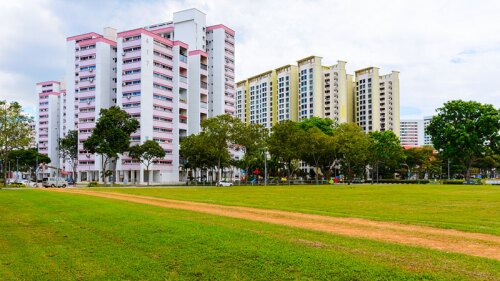Set to launch in 2023, the Punggol Digital District will form a fresh nexus between higher education and industrial innovation, with its two anchor institutions being the Singapore Institute of Technology (SIT) and a new business park developed by JTC Corporation, an industrial property developer and manager.
The “digital business district” in the northeast of Singapore, spread over 50 hectares (123 ac), will be integrated with surrounding residential areas and nature parks.
A recording of this conference is available on Knowledge Finder for ULI members.
Professor Tan Thiam Soon, SIT’s president, spoke with moderator Hwang Yu-Ning, chief planner and deputy CEO of Singapore’s Urban Redevelopment Authority, at the 2020 ULI Singapore Conference held virtually.
Tan talked about how SIT has taken the ongoing development of its upcoming campus in the work-in-progress district as an “opportunity for reimagination.”
By this, he referred to the need to reconsider the definition of education, since the current pandemic has necessitated remote learning, and what “the university learning environment of the future” should look like.
Formed in 2014, SIT is Singapore’s newest university, now with the third-largest student intake and the first to be based completely on cloud infrastructure. More than 90 percent of its enrollment comes from the five local “polytechnics.”
“We call ourselves a university of applied learning, the first in Singapore,” said Tan. “We offer a number of very unique programs and we place a lot of emphasis [in our pedagogy] on connecting academic knowledge to real-world application.”
To this end, SIT has introduced eight- to 12-month structured industry attachments, similar to internships or co-op programs in the United States, for its students.
“The fact that we have to work with industry, we recognized very quickly we really need to build a university that’s nimble and responsive. When industries are changing, we have to think very hard about how to respond to those changes,” said Tan.
“We see ourselves as a disruptive university and we are fortunate that, at this moment in time, we are building a new campus, which will be key to continue our journey of disruption.”
The promotional tagline for the Punggol Digital District is “The Future is Yours to Create.”
For SIT, being co-located with JTC’s business park through a pilot flexible land use arrangement, not far from the scenic waterfront facing Coney Island, also known as Pulau Serangoon, promises to greatly enhance symbiotic industry/academia collaboration for future generations.
Across the two organizations’ premises, developed with the same master planner and connected via dedicated links, including an elevated pedestrian walkway, there will be a co-mingling of physical facilities, such as research labs, learning facilities, incubator space, and maker space, as a result of deliberate space swaps.
In short, students and enterprises will find themselves as closely integrated as possible.
One key feature of the digital district, which is expected to bring forth 28,000 new digital economy jobs, arising from more than $15 billion in investment, across an area the size of 70 football fields, is the Open Digital Platform (ODP).
The ODP software uses sensors throughout the district, including more than 10,000 on the SIT campus, to integrate smart technologies such as robotics and the “internet of things” to gather data and derive real-time findings useful to companies, students, and public agencies.
As such, the entire Punggol Town precinct is meant to be a “living lab” to test new ways of living, learning, working, and delivering services. These include testing green technologies and sustainable urban solutions, which will abound throughout the district.
By the same token, the entire SIT campus, to be powered by its own “islandable” multi-energy microgrid, is being primed to facilitate learning, innovation, and experimentation.
“One of the things that we wanted to see is the university, not just the physical part, or the microgrid, but the university in totality being used for learning and experimentation,” said Tan, who also mulled the question, “Can we try completely new approaches and build a kind of space to facilitate that level of experimentation?
“We are really talking about a creating ‘living lab’ [with this campus] that would go beyond just the physical space to innovate and inspire learning, inspire interesting projects, and inspire industry to come and work with us,” he added.
Tan concluded the Learn session by sharing SIT’s approach to being a disrupter in education and being a crucial part of a lifelong work-learn continuum for its alumni.
“A lot of things we do, we didn’t do just to be different or innovative,” he said, highlighting the need for a university of applied learning to keep up with ever-changing trends and developments across multiple industries.
SIT also intends to remain relevant to alumni after they graduate.
“One of the ideas that we have been pursuing a lot in the last few years is this idea that once you enter university at SIT, you enter a work-learn continuum. Your whole life is [linked to this] continuum and you will never really graduate per se,” Tan said.
“In SIT, we have a motto: once a SIT-izen, always a SIT-izen. So how much will you learn throughout your career and when will you come back to SIT? We try to bring that message across very strongly to our students.”




